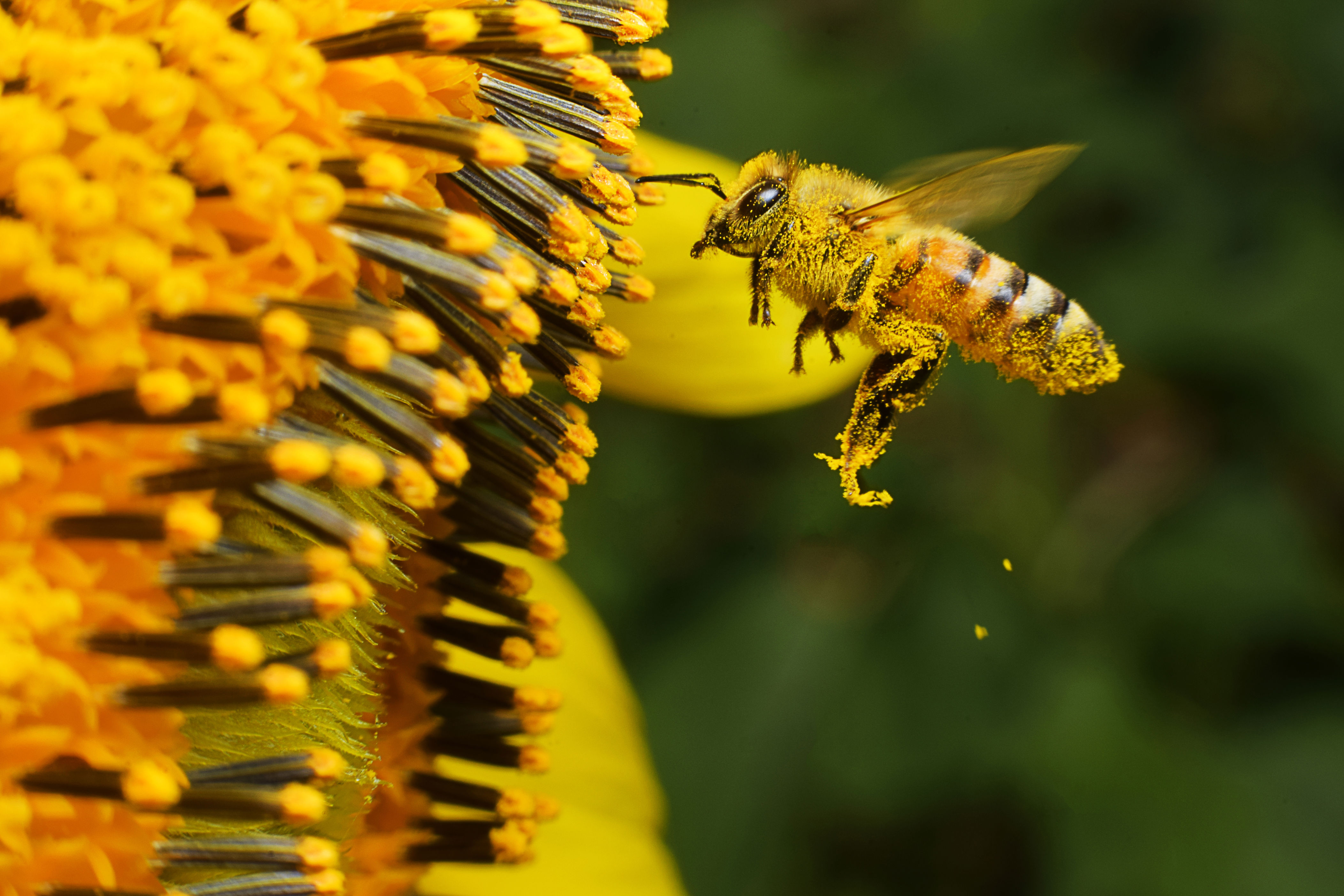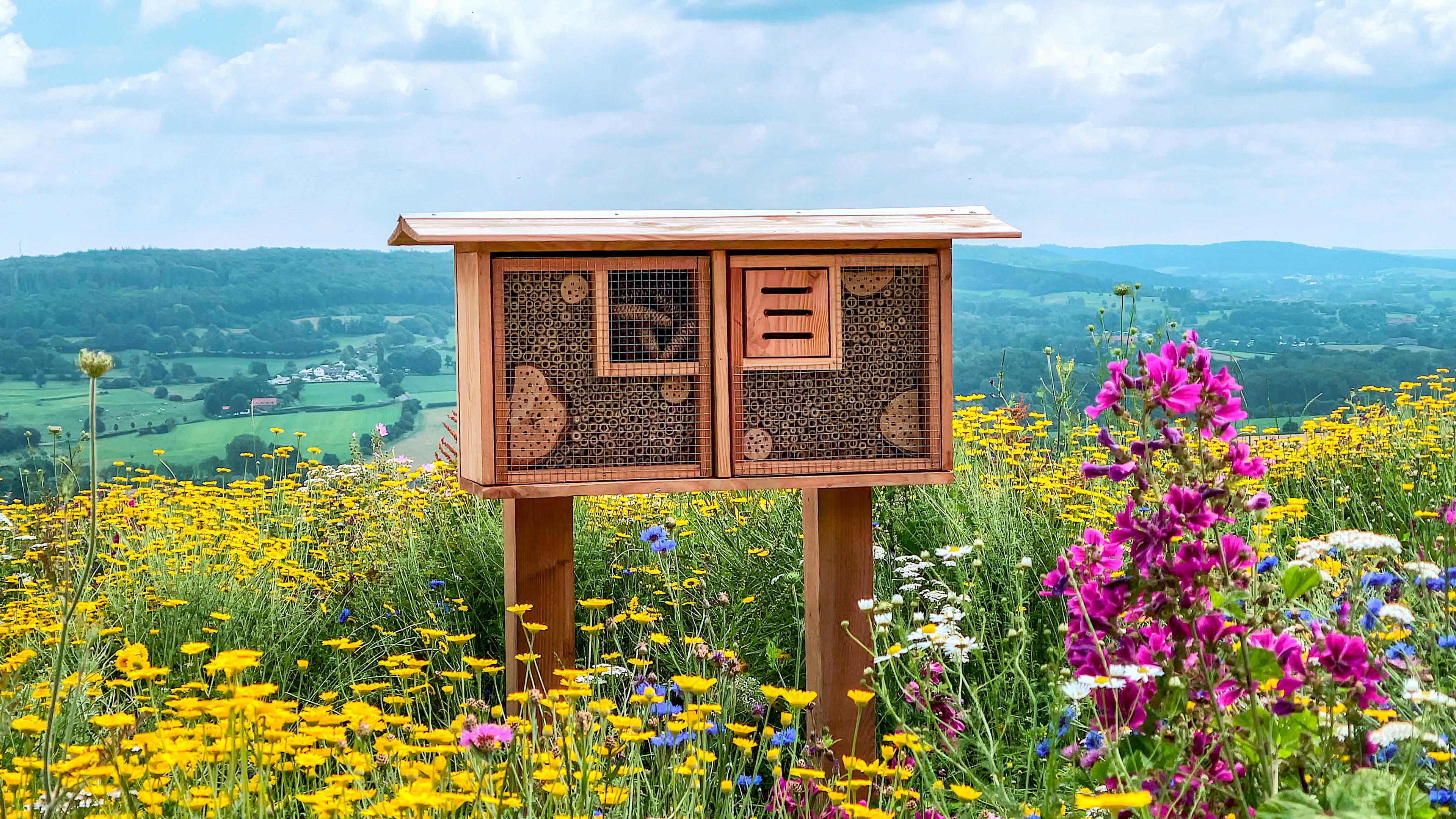Every spring, the air near my house hums. Bees and insects crisscross my yard searching for a sip of nectar, ferrying pollen between the golden poppies and California lilacs and bumbling across flower petals.
Each night, I assumed they flew back to their honeycombed castles. But believing all bees live in hives is like thinking all humans live in treehouses because you once saw someone climbing trees.
The truth was at my feet all along. Of the world’s 20,000 or so bee species, a whopping 70 percent dwell in the ground, while many of the rest shelter in hollow stems or dead trees. Just a tiny fraction live in hives.
This is an opportunity. Unlike other wildlife holding on in distant nature reserves, insects are ever-present in our lives, settling down in our yards, parks and even our homes. (The average home contains 100 insect species, virtually all of them harmless.)
Insects, a vast biological family composed of more than a million species, rank among the most successful organisms on the planet. No other animals can match their sheer diversity.
Yet they’re also suffering alarming declines some scientists call the “insect apocalypse.” Scientists are still working to pinpoint the exact causes — habitat destruction, poisons, pollution and rising temperatures all play a role.
Bees — along with the rest of class Insecta — need you. Rather than reach for a can of Raid, welcome lacewings, sweat bees and lady beetles into your life by building bug mansions on your balcony or in your backyard.
The best part? The laziest gardeners make the best bug architects.
Free bug labor
Insects, naturalist E.O. Wilson once said, are “the little things that run the world.” Two-thirds of the world’s known animals are insects, more than 1 million species at last count. Millions more are likely to be waiting in the wings. If world domination was a matter of abundance, there would be no competition. As many ladybug species (6,000) exist in the world as mammals. Weevils outnumber fish species. Longhorn beetles beat out birds.

Your yard can help avert the insect apocalypse. Here’s how.
All of them are working hard for you. “Busy as a bee” applies to almost every insect spending its life turning plants and organic matter into food for the rest of food chain, which then returns nutrients to the Earth (darkling beetle larvae can even eat Styrofoam). Insects pollinate most wild plants and global crops, the latter service valued at more than half a trillion dollars.
Yet our relationship with insects is fraught. Unless they’re biting or stinging us (and vanishingly few bugs do), most people can’t even identify them. The feared “daddy longlegs” spider in your cellar? It possesses neither fangs or injectable venom — it’s not even a spider (the gentle opilionid prefers to eat decaying organic matter).
With global insect populations declining (scientists are still debating how serious the declines are in North America), our backyards are potential refuges. Unfortunately, we’ve turned them into deathtraps — first, by removing any materials that might serve as shelter from the elements and predators, and then by dousing them in poison.
Many city dwellers and suburbanites clear their yards of any sheltering scrap of vegetation, then apply more insecticide per acre than farmers. That leaves behind a sterilized environment perfect for undesirable species, from cockroaches to mosquitoes to the tree-devouring spongy (formerly gypsy) moth. Healthy yards have self-regulating insect communities.
“The problem isn’t that we have too many bugs in cities and suburbs,” writes my colleague Dana Milbank. “The problem is that we don’t have nearly enough.”
‘Be a lazy gardener’
So I asked Scott Black, executive director of the Xerces Society, a nonprofit dedicated to invertebrate conservation: What can we do? Put down the pruners, he advised. Throttle back the mower. Less is more. A beautiful lawn is possible without manically manicuring every square inch.
“If you really want to invite insects to your yard, be a lazy gardener,” he says. “You can still have your garden look great with edges of manicured lawn, and the messiness out of the way. But it means less work so you don’t have to manicure all your lawn, and you’ll definitively get a lot more habitat.”
The key is to create a mosaic of natural habitats, from sticks to stems to leaves, that provide homes for the next generation of insects.
Like humans, insects need food and shelter. People focus on flowers. But few consider where all those busy insects live after summer fades. Nesting and overwintering habitat is one of the most important (and overlooked) ways to save insects. Here’s what Xerces recommends:
Save the stems
What do raspberries, bee balm, rose thistles and desert willows have in common? Bees, moths, wasps and spiders love living in their pithy stems, tiny high-rises for stem-nesting species (here’s a list of species to plant in your region).
Bees that settle on the perfect stem in the spring will partition the interior with walls of mud, leaves or flower petals. They deposit “bee bread” made of pollen and nectar, and lay an egg in each chamber. New generations overwinter in the stems, emerging again in the spring.
If you have a wildflower garden, leave the flower stalks over the winter as food for wildlife, and then trim the stalks early in the spring at a variety of heights about 8 to 24 inches off the ground. Plant a diversity of native shrubs. As a bonus, bundle leftover stems together for future nesters on the side of your yard. Insects will love your handiwork.
Leave the leaves
All those leaves are cozy apartments for moths and butterflies to wait out the winter. And they’re not alone: Snails, worms, beetles, millipedes, mites and more join them, supporting an intricate food web above them.
The leaves, ideally, stay on the landscape permanently. But if you do have a lawn, you don’t need to sacrifice it: Even a thin leaf layer atop the grass benefits insects and nourishes the grass beneath. If you do rake leaves, spread them on flower and planted beds, rather than wood mulch, a less hospitable material for insects.
Ground to burrow
Surburbia’s thick carpet of mulch, grass or pavement is nearly impenetrable to ground-nesting bees. By creating patches of loose, undisturbed soil, you furnish habitat for the 70 percent of bees that build their nests underground. They will dig their own or move into abandoned dens left behind by other animals. The broods are among the first to emerge each spring, pollinating early-blooming fruit trees and wildflowers.
You don’t need to banish grass. You can create plenty of space between plantings or relegate grass to accented borders around native plants (as I wrote about tidy wildlands here). Short-statured, bunching grass, rather than turf grass, can create semi-cleared spots between tufts. For delicious dandelion and clover to grow, set mower blades to the highest setting. Instead of mulching with wood chips, consider compost, which has a similar aesthetic, weed suppression and water retention — but is welcoming to nesting bees.
Logs and rock piles
Dead logs and snags are multilevel hotels. They provide the perfect place for beetles and other insects to tunnel, hide, forage and overwinter. Bees follow the beetles to build their nests in old tunnels, while spiders and other insect predators live in the moist underside. Butterflies overwinter in dryer parts of the log. “Planting” a log in your yard furnishes a mosaic of habitats for years or decades. Rock piles also offer protective crevices and cavities for bumble bees and mud dauber wasps, while ground beetles and other beneficial insects find shelter where soil meets stone.
Brush piles
Piling up wood branches and twigs is “one of the easier things you can do, and one of the most meaningful places for insects,” Black says.
Beetles dine on wood. Butterflies overwinter inside. Fireflies find daytime shelter. Songbirds flit through the dark hiding spaces.
A pile 2 to 10 feet by 3 to 10 feet in diameter works well. Any corner or out-of-the-way place will do. Or nestle it among plants, or add compost and soil above it to create a mounded garden.
Artificial habitats
Natural materials are best, but plenty of bee and insect hotels appear in gardens. Done right, these off-the-shelf (and DIY versions) can attract native and introduced bees and insects using materials such as tubes, stones, straw and drilled wooden blocks. One study found that 57 species, about one-fifth of the total species in the area, moved into an urban insect hotel.

A human-made “bee hotel.”
But given the risk of disease and predation, the verdict is still out on the conservation value of insect hotels, said Jennifer Hopwood, a pollinator conservation specialist with Xerces.
If you do use them for bees, limit the number of nest entrances (four to six), spread them out, and clean them at least every other year to reduce disease and parasite loads. You can order one or construct your own by drilling holes into non-treated lumber (here’s a step-by-step guide) or by bundling together tubes 1/16 of an inch to a half-inch in diameter, such as bamboo or reeds, with wire or packing them tightly into a container. Also add a water source (a saucer of water with small rocks works well) and turn off exterior lights.
Finally, go show it off
Plant a sign. It’s a small (or big!) signal showing off what you’ve accomplished, and why your neighbors might want to join. You’re creating more than habitat. As I’ve written, we’re all norm entrepreneurs. Shifting the national ideal of yards from impoverished monocultures to thriving landscapes means shifting the social norm of the American Dream.
Aim to create a living work of art.
News Related-
Russian court extends detention of Wall Street Journal reporter Gershkovich until end of January
-
Russian court extends detention of Wall Street Journal reporter Evan Gershkovich, arrested on espionage charges
-
Israel's economy recovered from previous wars with Hamas, but this one might go longer, hit harder
-
Stock market today: Asian shares mixed ahead of US consumer confidence and price data
-
EXCLUSIVE: ‘Sister Wives' star Christine Brown says her kids' happy marriages inspired her leave Kody Brown
-
NBA fans roast Clippers for losing to Nuggets without Jokic, Murray, Gordon
-
Panthers-Senators brawl ends in 10-minute penalty for all players on ice
-
CNBC Daily Open: Is record Black Friday sales spike a false dawn?
-
Freed Israeli hostage describes deteriorating conditions while being held by Hamas
-
High stakes and glitz mark the vote in Paris for the 2030 World Expo host
-
Biden’s unworkable nursing rule will harm seniors
-
Jalen Hurts: We did what we needed to do when it mattered the most
-
LeBron James takes NBA all-time minutes lead in career-worst loss
-
Vikings' Kevin O'Connell to evaluate Josh Dobbs, path forward at QB
